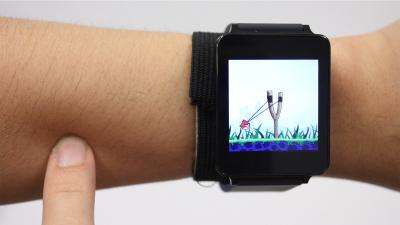CHI Preview: SkinTrack Technology Turns Arm Into Smartwatch Touchpad

Since the advent of smartwatches, technologists have been looking to expand interactions beyond the confines of the small watch face. A new wearable technology developed by HCII researchers suggests turning the entire lower arm into a touchpad.
Called SkinTrack and developed by the HCII's Future Interfaces Group, the new system allows for continuous touch tracking on the hands and arms. It can also detect touches at discrete locations on the skin, enabling functionality similar to buttons or slider controls. To do all this, it requires only that the user wear a special ring, which propagates a low-energy, high-frequency signal through the skin when the finger touches or nears the skin surface.
"The great thing about SkinTrack is that it's not obtrusive; watches and rings are items that people already wear every day," said Yang Zhang, a first-year HCII Ph.D. student. He will present details of the technology on Tuesday, May 10, at the Association for Computing Machinery's Conference on Human Factors in Computing (CHI 20106), in San Jose, Calif. (Check out a video explaining the technology on YouTube.)
"A major problem with smartwatches and other digital jewelry is that their screens are so tiny," said Gierad Laput, an HCII Ph.D. student and part of the research team. "Not only is the interaction area small, but your finger actually blocks much of the screen when you're using it. Input tends to be pretty basic, confined to a few buttons or some directional swipes."
"SkinTrack makes it possible to move interactions from the screen onto the arm, providing a much larger interface," said Chris Harrison, assistant professor in the HCII and adviser to the research. The user wears a ring that produces a high-frequency electrical signal. When the finger gets near the skin or touches the skin, that signal propagates through the skin.
Read the full story on the School of Computer Science website.
Story by Byron Spice

